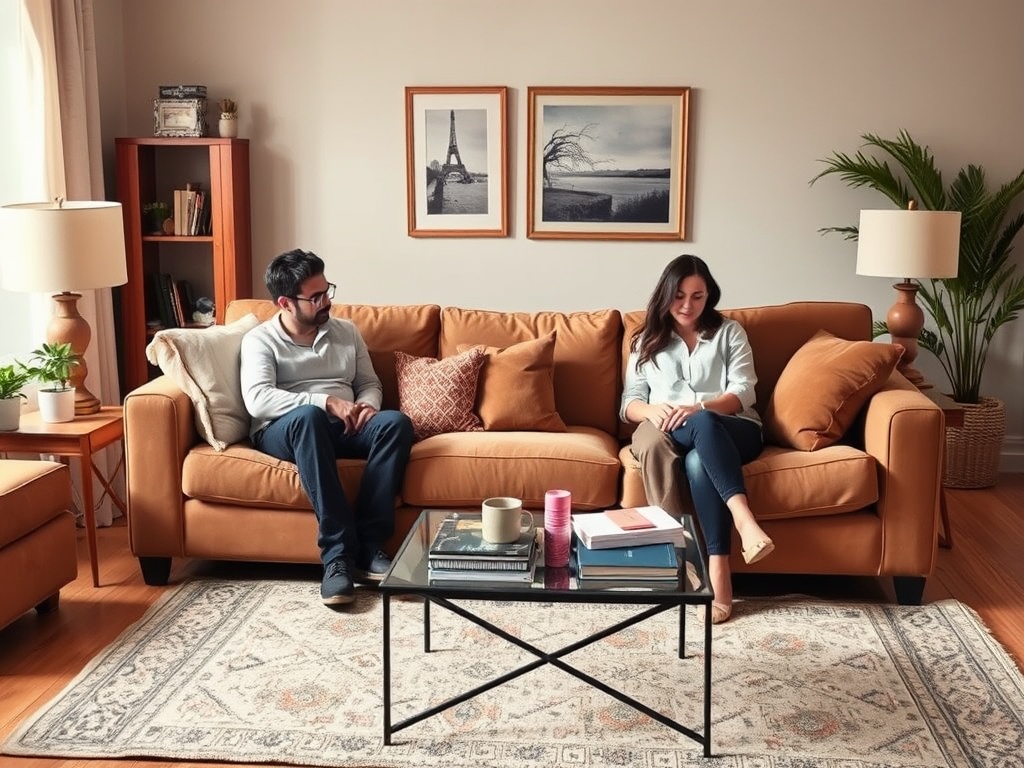Living with an Ex: The Complications of Shared Spaces After a Break-Up

When 34-year-old Chloe Bennet made the decision to cohabitate with her boyfriend, she didn’t foresee the possibility of a future split. At that time, their relationship had flourished for a year, and living together felt like a natural evolution. However, two years into their rental arrangement in Manchester, the couple began to grow apart. “There weren’t any dramatic fights or betrayals—our compatibility faded, and we stopped bringing joy to each other,” recalls Bennet. They ultimately decided to part ways in 2022. Yet, the aftermath of their breakup proved to be anything but easy, as they chose to continue sharing the same flat. They had renewed their lease just months before their split and still had around six months remaining. “We couldn’t afford to break the lease or move out immediately,” she explains. “We agreed to tough it out until the lease was up. In theory, it sounded feasible. In practice, it was quite complicated.”
The notion of living with an ex might seem intolerable to many. According to a study conducted in 2024, the trend is on the rise. A popular TikTok trend features creators documenting their experiences of cohabitating with an ex post-breakup, while research indicates that approximately 9 million Britons have continued to live with someone after their relationship has ended. The same study highlighted that individuals in their late 30s and 40s are the most likely to find themselves sharing a home with an ex, with four million adults having to cohabit with a former partner compared to 2.6 million younger adults aged 18-34.
Various factors contribute to this phenomenon, according to relationship expert and therapist Georgia Vass, including familiarity, financial constraints, parental responsibilities, and emotional readiness to move on. In many instances, one or both individuals may struggle to afford immediate relocation due to the remaining duration of their tenancy agreement, shared rental payments, mortgages, or delays in securing new accommodations.
With rents in the UK rising at the fastest pace in decades (recent ONS statistics reveal an annual increase of 9.2%), it has become increasingly challenging for those under 45 to secure homeownership compared to older generations. This situation is exacerbated by historically high property prices and restricted access to mortgage lending since the 2008 financial crisis. Paired with a housing shortage and a competitive rental market, finding new accommodations quickly is a daunting task.
Although Bennet’s breakup began on amicable terms, tensions soon escalated. They initially tried to maintain some of their previous routines, such as “ordering takeaways” or “watching our favorite shows” and agreed to refrain from inviting guests over out of “mutual respect.” However, the reality of their separation quickly became overwhelming. “The atmosphere became oddly tense whenever one of us went out without the other,” Bennet reflects. “We attempted to keep things civil, but conflicts arose, particularly over boundaries… I struggled immensely with daily reminders that our relationship had ended.”
“The entire situation was incredibly awkward, and the most challenging aspect was navigating the complexities of dating other people while living together,” Bennet continues. They both began seeing new partners three months after their breakup, but the situation escalated when her ex brought another woman back to their shared flat. “I wasn’t home when she arrived, but walking in and realizing another woman was in our space was devastating… I lost it. I accused him of being disrespectful, and he retorted that I had no right to dictate his actions.”
This confrontation marked a turning point for Chloe, who ultimately decided to leave the flat after the argument. They agreed that her ex would handle the financial responsibilities for the remainder of the lease. Unfortunately, she faced the added stress of securing a deposit on a new flat sooner than anticipated.
Phoebe Braddock, 24, encountered a similarly tumultuous experience when she chose to continue living with her ex in a rental flat in West Hampstead, London. “I initially moved into his one-bedroom flat because I had just graduated and had nowhere else to go,” she explains. However, when the couple split after three years, Braddock found herself unable to afford an early exit from their housing arrangement. “For the last four months of our lease, he basically slept in the spare room while I occupied the main room,” she elaborates. “It was such a bizarre situation; you’re trying to break up, yet you’re still cohabitating.” Braddock describes those four months as utterly “horrid.” “We became like housemates,” she states.
According to Andrew Boast, a housing expert and CEO and co-founder of SAM Conveyancing, the cost-of-living crisis is compelling many ex-partners to remain under the same roof. The financial aspects also play a significant role in couples’ decisions to move in together initially. Research from house-sharing site SpareRoom indicates that 24 percent of individuals would consider cohabitating with their partner sooner than planned due to financial pressures. “Saving money was a crucial factor in our decision to move in together,” Bennet acknowledges. “Our high rent became manageable once we started sharing costs.”
“Whether renting or buying, couples should always carefully evaluate their decision to live together,” advises Boast. “The benefits of combining resources and the straightforward math of one room versus two should not overshadow a pragmatic assessment of the pros and cons.” He suggests opting for a shorter lease if it’s a couple’s first time living together: “This way, if there are too many annoying ‘toilet seat left up’ moments, the couple can find a workable and quick end to their living arrangement.”
Looking back, Bennet wishes she had considered the potential for her relationship to end before signing the housing contract. “Sharing an apartment seemed financially logical, but I regret that we didn’t discuss the possibility of a breakup,” she admits. “We probably should have ended our relationship earlier, but the thought of sorting out living expenses and dividing our belongings felt overwhelming.”
Financial strain isn’t the sole reason some couples choose to remain under the same roof. Despite being aware that he and his wife “were planning on separating,” 49-year-old Parker* continued to live in their shared home in Birmingham with their two children for nearly two years. “We had come to the conclusion that we were no longer happy, but moving out made everything feel more real,” he shares. Parker and his wife initially aimed to keep their breakup a secret from their children for their well-being, as “our priority was to avoid disrupting the children’s lives.” Financial considerations also contributed to their decision to cohabit. “Neither of us wanted to lose our home or incur thousands in legal fees,” he explains. “We knew the breakup would be challenging enough without the added stress of dividing everything.”
However, Parker describes living with his ex-wife as a “minefield.” “Everything that used to feel normal, like having dinner together as a family or socializing with friends, began to feel unnatural.” Ultimately, he decided to leave last year. “That’s when I realized things were definitively over—we were arguing frequently, and both of us were pretty bitter.” However, he confesses that moving out of the family home was “equally, if not more distressing.” “My ex and I argue less now, and the children have adjusted to us not being together, but everything I took for granted has changed.”
They have since initiated divorce proceedings, and Parker continues to contribute to the mortgage of their family home. He acknowledges that having children adds an “additional layer of logistics” to the separation process. In his case, he needed to find a rental flat nearby to remain close to his young family while he and his ex navigate their joint home situation. “The children’s needs come first, but it has complicated things. I think we delayed our separation because we wanted to avoid dealing with all the administrative tasks and costs.”
For many, even when dissatisfied with their partner, the potential costs of finding alternative accommodations can feel too overwhelming, considering factors like council tax, bills, and rent. Nevertheless, Vass warns that “living with an ex could harm well-being” and may lead to heightened tension, emotional confusion, resentment, and conflict. She advises couples to contemplate their motivations for wanting to live together before making such a decision. “The dynamics change drastically when you cohabitate, and the chance of conflict increases. It can rapidly expose differences between partners.”
Bennet remembers her experience as an “emotional rollercoaster,” while Parker reflects that he “would think twice” before agreeing to live with an ex again, saying, “It prolonged and intensified the pain of our breakup. Next time, I’d rip the Band-Aid off quickly.” Braddock expresses sadness when she reflects on her time living with her ex and vows never to do it again. “The most significant struggle was being in the flat, surrounded by our shared belongings—things we had purchased together, photos of us—essentially, the life we had built together,” she laments.
Regardless of their reasons, couples who have separated but still share a living space should remember to “be kind” to themselves, advises Vass. “This is a complicated situation.”
*Names have been changed.




